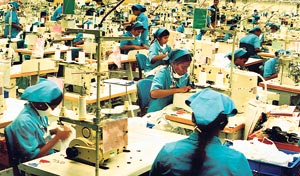Due to the limitations of natural resources Sri Lanka has been heavily dependent on imports for energy (petroleum, gas, and other fuels), food, capital equipment and the import bill has been growing at a steady rate. However export growth has been below expectation excepting for occasional commodity booms that provided temporary surpluses.
Since the economic reforms of 1977 liberalization, export-led growth produced a success story in the apparel and garment industry which is now a mainstay in exports. Export of computer software and processed gemstones are yet to emerge with significant numbers. Thus Sri Lanka has been operating within a Rs 5 billion trade gap.
Recently trade surpluses were recorded, however this phenomenon was mainly due to the curtailment of industrial goods imports and lower import prices of certain commodities including petroleum products; hence it cannot be credited to sustainable economic growth. A key factor of the country’s external financing, worker remittances now account for nearly $4 billion. This is a vulnerability in the economy.
The theory of “Export or Perish” is a necessity for Sri Lanka to improve its external financing. No magic formula or shortcut is available to enhance export volumes. We need to critically examine the impediments for export growth and how to eliminate them. The challenges are enormous. In 2009 exports amounted to $7 billion of which tea accounted for $1.2 billion and textiles and garments accounted for $3.2 billion thus representing over 50% of the exports . Both these export industries have fared remarkably well overcoming many obstacles including the contracted demand arising from the global crisis. These two sectors have ventured successfully into quality enhancement and brandings and the results have been rewarding.
The garment industry faces a daunting challenge consequent to the temporary suspension of the GSP+ facility by the European Commission. Sri Lanka and 14 other countries were granted this facility in 2005, becoming the sole beneficiary from South Asia. Currently the GSP+ facility is in doubt. Notwithstanding the government stand that the exporters would be able to overcome this setback it seems an enormous challenge. It’s not only the garments that are affected, but also in the affected list are other exports mostly from the SME sector. Well managed garment exporters with vertical integration, branding, technology may succeed in weathering the storm. Nevertheless good economic diplomacy even at this stage could mend fences.
Apart from the GSP+ issues the whole export sector does not seem to be getting adequate attention from government authorities. For many years the VAT refund issue has caused enormous headaches to the exporters. This delay brings in an enormous interest and credit problem to the exporters. In recent times some assurances have been made but the problem is far from resolved.
The EDRS scheme was designed to assist the exporters who were affected by the global economic crisis of 2008. It was a good proposal but the implementation seems to have not been smooth with only one quarter being settled. One wonders whether the Department of Commerce with its varied duties could handle such a cumbersome process and if not cannot the Export Development Board which is more familiar with the intricacies of the export goods/services and the process, do better?
Tea has played a pivotal role in the country’s economy. Though the transfer of the industry stakes from the British to locals was inevitable the industry faced a major crisis due to obvious limitations arising from state ownership. But this is now history and the industry and the exporters emerged stronger with current auction price levels reaching nearly $ 4 per kg.
How do we advance from this stage to enhance the export earnings? It is clearly understood that a major expansion of the tea crop is not feasible due to obvious limitations such as land and yields. It was with this foresight that during the 1980’s in the aftermath of the economic liberalization the “tea hub” concept was given thought and import of tea of selected varieties were permitted to boost value addition.
This did pay dividends as and Sri Lanka’s value added Tea exports increased in quantity and value. It was in this background that Unilever was in the process of moving its packing of tea bags and packets for Middle East to a location in the east. Colombo was a considered location and in fact some production was transferred to the Lipton factory in Mabole. That was shortlived due to the rigidity of import regulations and Jebel Ali in Dubai was preferred. Thus Sri Lanka lost its opportunity.
If tea exports are to realize it’s true potential as a forex earner it’s time the regulators, exporters and the producers seek consensus. Apart from Dubai, Russia too has commenced importing multi-origin teas and moving to on shore packing, this has already affected the tea bag export volumes. Sri Lanka must not let the opportunities slip away during it’s quest for resurgence. |


